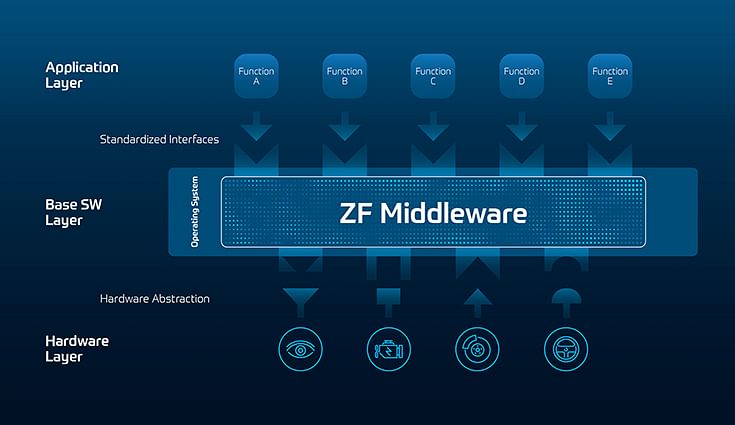ZF to showcase ‘Middleware’ open software platform at CES 2021
Key functions of the middleware are the abstraction of computing hardware from software applications and the communication between these applications.
The vehicle of the future will feature high levels of networking and automation defined by software. But a ‘software-defined car’ is much more than a ‘smartphone on wheels’ even if the vehicle operation increasingly resembles that of a smartphone. The difference is the quality and quantity of hardware systems that need to be intelligently connected by a software platform to help move people comfortably and safely.
In a preview to CES 2021, ZF has presented its new middleware. This open software platform is a ‘mediator’ between a vehicle computer’s operating system and its software applications. Key functions of the middleware are the abstraction of computing hardware from software applications and the communication between these applications.

“The new ZF middleware underpins ZF’s claim to be one of the world’s leading system suppliers for the software-defined car of the future,” says Dr. Dirk Walliser, Senior Vice-President Research & Development, Innovation & Technology at ZF. “Our customers benefit from accelerated development processes and significantly reduced complexity when integrating hardware and software. Throughout the vehicle’s lifetime functions can be updated or additionally offered on-demand.”
As a comprehensive software platform, the ZF middleware will be available in series vehicles from 2024. Its development is closely connected to the development of application software for mobility domains like automated driving, integrated safety, vehicle motion control and electric mobility.

System solutions for the software-defined car
Bits and bytes have been allowing vehicle components to communicate with each other for almost five decades since the first electronic control units (ECUs) were installed in cars in the 1970s. Today, vehicles may have up to 100 different ECUs. Each of them includes its own software. In new and future vehicle platforms, the electric and electronic architecture (E/E architecture) will change dramatically. Software functions move away from decentralised controllers towards a centralised system with only a few dedicated domain control units (DCUs), e.g. for automated driving functions. All these software applications benefit from a smoothly integrated middleware platform managing system integration.
Reduced complexity for system integration
Being a connector to the software applications and the hardware components of a vehicle, only the middleware needs to be connected to the operating system. This approach minimises the interfaces, guarantees fast communication with all parts of the system and can help to significantly reduce the complexity of system integration for the OEM.
The same principle applies for the development of hardware components. The middleware simplifies their flexible integration into vehicles providing communication in “one universal language”. It “translates” and standardizes the communication between the vehicles different hard- and software layers.
Accelerated and improved processes
The open hard- and software architecture enables an accelerated and improved development process between ZF, vehicle manufacturers and other partners – from the first step of development and during the entire lifetime of the vehicle. As a result, vehicle manufacturers and end customers benefit from innovative vehicle functions that are always state-of-the-art.
Depending on the OEM’s software architecture, ZF offers a modular approach with its middleware from a full platform solution to single modules that can be integrated into the OEM’s software platform. Thanks to its own scalable ZF ProAI supercomputing platform for next generation vehicles, ZF says it is capable of providing traditional and new automotive customers with comprehensive systems comprising software, computing and sensor hardware as well as connected actuators.
RELATED ARTICLES
Skoda begins sale of made-in-India CKD Kushaq in Vietnam
Before production started, pre-series Kushaq vehicles covered over 330,000 kilometres on a variety of Vietnamese roads a...
Six Japanese companies join forces to expand use of recycled materials in new vehicles
Denso, Toray Industries, Nomura Research Institute, Honda Motor, Matec Inc and Rever Corporation have set up the BlueReb...
BYD selects Voestalpine as steel supplier for its Hungarian plant
The announcement of the Austrian steelmaker as a supplier demonstrates BYD’s strategic plan to source from high-quality,...





 By Autocar Professional Bureau
By Autocar Professional Bureau
 28 Dec 2020
28 Dec 2020
 6532 Views
6532 Views














